|
|
|
AVIONS ET CONSTRUCTEURS PAR PAYS
![]() Argentina
Argentina
![]() Australia
Australia ![]() Austria
Austria ![]() Belgium
Belgium ![]() Bolivia
Bolivia
![]() Brazil
Brazil
![]() Bulgaria
Bulgaria ![]() Canada
Canada ![]() Chile
Chile
![]() China
China
![]() Colombie
Colombie
![]() Czechoslovakia
Czechoslovakia
![]() Denmark
Denmark
![]() Ecuador
Ecuador
![]() Egypt
Egypt
![]() Estonia
Estonia
![]() Ethiopa
Ethiopa
![]() Finland
Finland
![]() France
France
![]() Germany
Germany
![]() E.
Germany
E.
Germany ![]() Greece
Greece
![]() Hungary
Hungary
![]() India
India
![]() Indonesia
Indonesia
![]() Iran
Iran
![]() Israel
Israel
![]() Italie
Italie
![]() Japan
Japan
![]() Latvia
Latvia
![]() Lithuania
Lithuania
![]() Mexico
Mexico
![]() Moldavia
Moldavia
![]() Netherlands
Netherlands
![]() New
Zealand
New
Zealand ![]() Norway
Norway
![]() North
Korea
North
Korea ![]() Pakistan
Pakistan
![]() Paraguay
Paraguay
![]() Peruvia
Peruvia
![]() Philippines
Philippines
![]() Poland
Poland
![]() Puerto
Rico
Puerto
Rico ![]() Romania
Romania
![]() Singapore
Singapore
![]() S.
Africa
S.
Africa ![]() South
Korea
South
Korea ![]() Spain
Spain
![]() Sweden
Sweden
![]() Switzerland
Switzerland
![]() Turquey
Turquey
![]() Taiwan
Taiwan
![]() United
Kingdom
United
Kingdom ![]() Uruguay
Uruguay
![]() U.S.A.
U.S.A.
![]() Venezuela
Venezuela
![]() Yugoslavia
Yugoslavia
| TOUS |
wiki-fr wiki-en
Brazilian
Air Force Aircraft
Directory: Brazil 
| Aerotec (Brésil) Sociedade Aerotec Ltda., EngenhariaAeronautica formed 1968. |
| A-122 (T-23) UIRAPURU Учебно-тренировочный самолет A-122 (T-23) Formation Uirapuru avion |
AVIBRAS
Sociedade Avibras Ltda. in 1963 was testing prototype of A-80
Falcao, a side-by-side two-seat low-wing monoplane of wooden
construction with plastic skin. Brazilian government contracts
received for several projects, including single-seater with
Volkswagen engine, but in 1967 the company withdrew from the
aviation industry.
CENTRO TECNICO DE AERONAUTICA ==> above CTA.
CNNA
Companhia Nacional de Navegagao Aerea, took over manufacture
of Muniz-designed aircraft from Companhia Nacional de
Navegagao Costiera (CNNC, q.v.) around 1941. Produced Muniz
M-11 two-seat primary trainer, designated HL-1, with strong
resemblance to Piper Cub; batch of 50 HL-6 tandem two-seat
low-wing monoplane trainers was begun 1943. Other designs
included HL-2 and HL-4. In 1947, improved Series B versions of
the HL-1 and HL-6 appeared; the company's activities had
ceased by about 1950.
CNNC
Companhia Nacional de Navegagao Costiera, founded at llha do
Viana, Rio de Janeiro, in late 1930s to manufacture
Muniz-designed M-7 and M-9 biplane trainers; basically an Army
aircraft workshop. In early 1940s renamed Fabrica Brasileira
de Avioes (q.v.); see also Muniz.
COMPANHIA NACIONAL DE AVIOES LTDA ==> below CONAL.
CONAL
The name stands for Companhia Nacional de Avioes Ltda. A
prototype five-seat high-wing cabin monoplane Conal W-151
Sopocaba was designed and flown in August 1964, but none was
produced. The company was licensed for conversions of the
Dumod I and Dumod Liner made by the Right: Conroy Airlift,
American Dumod Corporation (q.v.), but apparently none an
outsize Canadair was built.
COSTRUQOES AERONAUTICAS SA
Originated May 1940 as government-backed private company under
French designer Rene
Couzinet (q.v.), at Lagao Santa, Minas Gerais, to
build civil and military aircraft. First license was for North
American NA-16 (AT-6 Texan see North
American)
advanced trainer, but none produced.
CTA
Centra Tecnico de Aeronautica, established at
Sao Jose dos Campos as aeronautical research center in late
1950s by Brazilian Air Ministry; CTA originally had two
divisions. A group within the IPD (Research and Development
Division), Departamento de Aeronaves (q.v.) or PAR, was
responsible for the BF-1 Beija-Flir (Humming Bird) two-seat
helicopter, first to be designed, built and flown in Brazil.
CTA
Centra Tecnico Aerospacial developed reengining program for
Paulistinha lightplane, with IMAERTM 2000 EM1 piston engine,
as Paulistinha 65.
DEPARTAMENTO DE AERONAVES
(PAR)
The aircraft department of the Instituto de Pesquisas e
Desenvolvimento (IPD). From 1970 concentrated entirely on
research, all design and development being handed over to
Embraer. Between 1959 and 1964 it developed prototypes of the
Beija-Flor two-seat light helicopter, designed especially for
Brazilian conditions by Prof. Heinrich Focke, formerly of
Focke-Achgelis.
 |
| EMB-110/111 Bandeirante |
EMPRESA BRASILIERA DE
AERONAUTICA SA ==> above EMBRAER
FOKKER INDUSTRIA
AERONAUTICASA
Initial production of 100 Fokker S-11 two-seat primary
trainers, followed by 50 examples of S-12 tricycle-landing-
gear version. Five S-14 Mach trainers assembled from
Dutch-made components, before construction of 45 locally
manufactured aircraft.
GALLEAO
Former naval workshops which built aircraft for Brazilian
Air Force, including Focke-Wulf Fw 44 primary trainers and
Fw 58 twin-engined advanced trainers. In 1946 a batch of
Fairchild PT-19 trainers was built under a license
agreement.
HELICOPTEROS DO BRASIL
SA
Founded 1978, with partial Aerospatiale of France
shareholding, to assemble Aerospatiale SA 315B Lama and AS
350B Ecureuil helicopters, known locally as HB 315B Gaviao and
HB 350B Esquilo respectively. Current programs encompass
continued assembly of Esquilo plus the military AS 550 Fennec
version, and AS 365 Dauphin and military AS 565 Panther (all
Eurocopter types)
IABSA
Industria Aeronautica Brasileira SA produced in the late 1960s
a two-seat lightweight primary trainer/sporting aircraft under
the designation IABSA Premier 64-01. A single-seat aerobatic
biplane, the IABSA Aerobatic 65-02, was under development.
INDUSTRIA AERONAUTICA BRASILEIRA SA ==> above IABSA.
INDUSTRIA AERONAUTICA
NEIVA SA
Formerly Sociedade Construtora Aeronautica Neiva Ltda, and
since March 1980 a subsidiary of EMBRAER, when all work on the
EMBRAER/Piper series of light aircraft and production of the
EMB-202 Ipanema agricultural aircraft were transferred (over
780 built). Including earlier company, Neiva has produced over
3,200 aircraft since 1956, many under license from Piper and
including Ipanemas, Urupema gliders, Cariocas, Coriscos,
Tupis, Minuanos, Sertanejos, Senecas/Cuestas, Navajos, and
Carajas.
INDUSTRIA PARANAENSE DE
ESTRUTURAS LTDA.
Developed IPE 06 Curucaca very light tandem two-seat monoplane
(first flown 1990).
INSTITUTO DE PESIQUAS TECHNOLOGICAS ==>below IPT.
IPT
Institute de Pesiquas Technologicas (National Institute of
Technical Research) was concerned primarily with research into
materials suitable for use by the national aircraft industry.
Was also responsible for the construction of a small number of
lightweight cabin monoplanes.
M.M. Super Rotor
LTDA.
AC.4 single-seat autogyro dated from 1970s as a design of
Altair Coelho. Marketed by this company after purchase of
rights and many sold in assembled and kit forms.
MIGNET DO BRASIL
Formed early 1950s to build Mignet H.M.310 Estafette two-seat
modernised version of the designer's earlier Poudu- Ciel light
aircraft; new development flown 1951 with Continental A90
engine.
| MUNIZ (Brésil) 1935 |
| M-7 Учебно-тренировочный самолет M-7 Formation avion |
| Neiva (Brésil) entreprise brésilienne Construtora Sociedate Ltd Aeronautica Neiva (plus tard, Empresa Brasileira de Aeronautica SA) |
| 621 UNIVERSAL Учебно-тренировочный
самолет 621
UNIVERSAL formation avion АТ-25 UNIVERSAL Учебно-тренировочный самолет RT-25 UNIVERSAL Avions |
NEIVA ==> below Sociedade Construtora Aeronautica Neiva Ltda.
OMAREAL
Oficina de Manutenco e Recuperaceo de Avioes Ltda, the
Brazilian maintenance and overhaul facility based at Sao
Paulo, acquired manufacturing rights to the Casmuniz 52
twin-engined five-seat lightplane in 1955. Designed and built
by Cassio Muniz SA (q.v.), the Casmuniz 52 was intended for
easy construction from single-curvature metal to facilitate
field repair in bush operations. OMAREAL took over the flight
testing of the sole prototype, but no production ensued
PARQUE DE
AERONAUTICA
The works at Rio de Janeiro's military air base built Waco
biplanes for Brazilian Air Force mail services in late 1930s,
plus Muniz two-seat training monoplane.
SOCIEDADE CONSTRUTORA
AERONAUTICA NEIVA LTDA
Neiva produced Model N621/T-25 Universal trainers for the
Brazilian Air Force and a series of lightplanes. In March 1980
it was renamed Industria Aeronautica Neiva S.A (q.v.), as a
subsidiary of EMBRAER.
SUPER M.M. ROTOR INDUSTRIA
AERONAUTICA LTDA.
Developed AC-4 Andorinha single-seat autogyro (first flown
1972) and M-1 Montalva two-seat autogyro (first flown 1985).

In 1875, Júlio Cesar Ribeiro de Souza, born in belém, a city located in northern brazil, started some research in aeronautics because he was impressed with the flight of certain native birds of the amazon rain forest. he moved to rio de janeiro, where he published works on air navigation and presented talks on this subject to the instituto politécnico, an engineering faculty. he designed a dirigible, which was christened victória after his wife. after obtaining part of the funding in brazil, the device was constructed in paris. attempts to place the device airborne failed both in france and in brazil. back to his native city he created a workshop to produce hydrogen gas for the machines that he invented. júlio finally succeeded with his dream of pursuing the air navigation with the flight of another dirigible, called cruzeiro, in 1886 in paris. 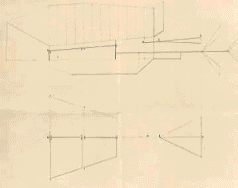 drawing belonging to the patent request for the dirigible victória designed by júlio cesar de souza (1881). source: brazilian national archives another brazilian, Severo Augusto de Albuquerque Maranhão, born in macaíba, rio grande do norte state in the northeast of brazil, designed and flew the dirigible bartolomeu de gusmão in rio de janeiro in 1894. he also developed and constructed a second machine, the pax. two four-cylinder buchet engines with 16 and 24 hp powered the pax. two pusher propellers set at 50 rpm drove the aircraft. the forward and aft propeller diameters were 5 and 6m, respectively. in addition, two other propellers were placed normal to the machine's longitudinal axis for lateral control, only. a further propeller was placed below the deck and was employed to control the pitch movement of the 30-m-long aircraft. maranhão had some insights in designing the pax, which were not taken into account by his predecessors. one of them was the placement of the traction line coincident with the drag one to better control and handling of the aircraft. however, he unfortunately died during his flight on the pax in mai 12th, 1902 in paris.  dirigible bartolomeu de gusmao in rio de janeiro, 1894. source: museé de l’air, france. 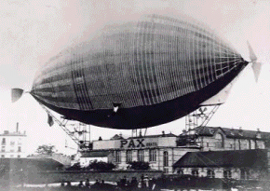 the dirigible pax designed by severo maranhão was constructed in paris. source: museé de l’air, france. The aviation also changed after the Brazilian Alberto Santos Dumont. Alberto Santos Dumont was born on July 20th, 1873, in the village of Cabangu, State of Minas Gerais, Brazil. At the age of 18, his father sent Santos Dumont to Paris where he devoted his time to the studies of chemistry, physics, astronomy and mechanics. He had a dream and an objective: to fly. In 1898, Santos-Dumont went up in his first balloon. It was round and unusually small and he called it Brésil (Brazil). However, it was capable of lifting a payload of 114.4 lb, and had in its lower part a wicker basket. His second balloon, "America," had 500 m3 of capacity and gave Santos Dumont the Aero Club of Paris' award for the study of atmospheric currents. Twelve balloons participated in this competition but "America" reached a greater altitude and remained in the air for 22 hours. Between 1898 and 1905 he built and flew 11 dirigibles. Contrary to the prevailing common sense at that time, he employed in his lighter-than-air aircraft piston-powered engines with the lifting-gas hydrogen. He won the Deutsch Prize, which was conceived and granted by the oil tycoon Deustch de la Merthe, when for the first time in the history a dirigible went around the Eiffel tower on October 19th, 1901. This prize amounting 100,000 Francs stipulated a dirigible ride comprised of a flight with takeoff and landing at the Saint-Cloud field with a total duration of 30 minutes, including the going around the Eiffel Tower. In 1904, Santos Dumont came to the United States and was invited to the White House to meet President Theodore Roosevelt, who was very interested in the possible use of dirigibles in naval warfare. The interesting thing is that Santos-Dumont and the Wright brothers never met, even though they had heard of each other's work. |
||
|
||
Louis Cartier invented the wristwatch for his famous friend, Alberto Santos Dumont, in March of 1904. They had met and become good friends in 1900. Santos Dumont's Deustch Prize conquest was celebrated at Maxim's that evening, and at some point Santos Dumont complained to Cartier about the difficulty of checking his pocket watch to time his performance. He wanted his friend to come up with an alternative that would permit him to keep both hands on the controls. Louis Cartier went to work on the idea and the result was a watch with a leather band and a small buckle, to be worn on the wrist. Santos-Dumont never took off again without his personal Cartier wristwatch. |
||
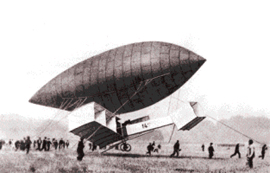
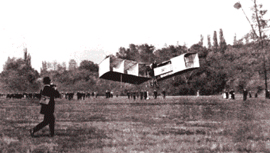
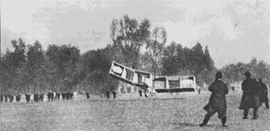
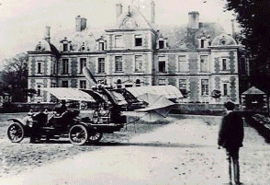

 |
 |
| Convertiplano’s fuselage and engine workbench. Source: Centro Técnico Aeroespacial.  The Beija-Flor Helicopter. Source: Centro Técnico Aeroespacial |
|
LIENS & sources
![]()

![]() Très site tenu par Maksim
Starostin in Estonia.
Très site tenu par Maksim
Starostin in Estonia.
Alphabetical List of Aircraft : A A
| B
| C
| D
| E
| F
| G
| H
| I
| J
| K
| L
| M
| N
| O
| P
| Q
| R
| S
| T
| U
| V
| W
| X
| Y
| Z
Aircraft Manufacturers:
AA | B
| C
| D
| E
| F
| G
| H
| I
| J
| K
| L
| M
| N
| O
| P
| Q
| R
| S
| T
| U
| V
| W
| X
| Y
| Z
The Probert Encyclopaedia of Aircraft
Galerie
site polonais ( site
polonais samoloty.ow.pl/ ) INDEX
Sites le
Peps ![]()
![]()

![]() En
dépit du soin apporté à la rédaction de ces pages, il est
toujours possible qu'une erreur se soit glissée. Je vous
remercie de me faire part (cliquez sur l'icône E-MAIL) de
toute anomalie, afin de pouvoir la rectifier dans les
meilleurs délais. Il est possible aussi que certaines images
et certains textes n'appartiennent pas au domaine public. Dans
ce cas merci de m'indiquer le fonds documentaire concerné et
les propriétaires de l'œuvre afin que je fasse le nécessaire.
En
dépit du soin apporté à la rédaction de ces pages, il est
toujours possible qu'une erreur se soit glissée. Je vous
remercie de me faire part (cliquez sur l'icône E-MAIL) de
toute anomalie, afin de pouvoir la rectifier dans les
meilleurs délais. Il est possible aussi que certaines images
et certains textes n'appartiennent pas au domaine public. Dans
ce cas merci de m'indiquer le fonds documentaire concerné et
les propriétaires de l'œuvre afin que je fasse le nécessaire.